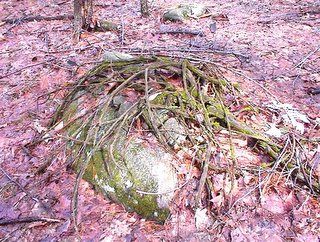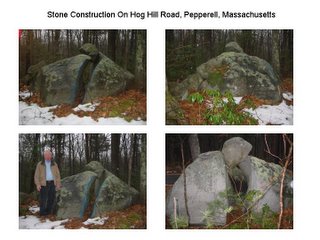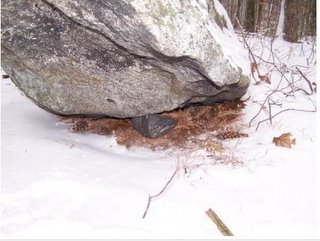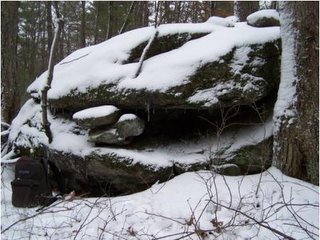 This is relevant to the topic discussed here that cedar trees were sometimes planted as memorials. Herman Bender, a researcher working in the upper midwest, sent some interesting information about trees in the Ojibway idea of Paradise.
This is relevant to the topic discussed here that cedar trees were sometimes planted as memorials. Herman Bender, a researcher working in the upper midwest, sent some interesting information about trees in the Ojibway idea of Paradise.
The text reads:
Figure 2. The Ojibwa map of the "path for souls" or the road to paradise drawn for J.G.Kohl in the mid-19th century. Slightly different versions but always with the same elements appear in the Mide Ghost Scrolls. Explanation is as follows: 'A' is the (created) earth upon which "God has planted his law, like a tree (B) straight updwards". "Some wander the right path (B), but many get on the side-paths of the lane (a a a a). These run into the desert". "When men die, they all go, after death, along the path of souls (C). On the center of this path (at D) thou seest the strawberry lying on one side. It is extraordinarily large..." After a "journey of from three to four days...a large broad river (E) bars the way. Over it there is no regular bridge. Something that looks like a great tree-stump (F) lies across it...In reality, it is a great serpent, which has its tail on the opposite shore, and thrusts forth its head to this side. On this head the souls are obliged to leap". The Great Spirit grieved for men and "ordered Manabojuto prepare a paradis (G)...in the west", or "the direction of the setting sun" accoriding to the Mide Ghost scrolls. The name for Paradise was "Wakui or Wakwi"."With that, the Indian told me [he] wished to designate the paradise of the Christians. They...had also a paradise (X and Z) ...He knew nothing at all of its nature, but he [drew] it for the sake of giving me a perfect idea" Kohl 1860:215-219)------------------------------------------------------------------
Herman also sent the following references to cedar trees in texts about the Indians. I apologize for not being able to read all the notes:
The Shaman (by John Grim)
CEDARS - SPECIFICALLY RED CEDAR
pg. 6 (footnote) or actual Manitou
pgs.78-81 Cedar (?) tree used for Cosmic Axis see: (pg.77 of History of the Ojibway People by William Warren) (pg.481 of the NAtive Americand of N.A. by Str... and Taylor)
pg.132 (picture caption) Cedar boughs 4 ft. thick ... Mide Lodge ([80'x20']) floor
DE-COO-DAH (propogated on graves)
pg.111 as a sacred tree (to Winnebago)
pg.77 "Medawautig, a cedar post...in center of lodge..." by Selwyn Dewdnypg. illustration of Mide Scrolls by S. Dewdny
pg. Manitou - Scared Landscape...MAvor & Dixpg. cedar burned to divine future (see also pg.354 in Indians of the Western great Lakes.
* In Oakfield Township, cedars appear to be especially prevalent conspicuous at ...
----------------------------------------
Writing about these notes, Herman adds:
The De-Coo-dah reference from the 1840's was pretty straight forward. The cedar he was talking about was planted on an earthen mound, but I can see where the trees might symbolize the 'axis-mundi' on a cairn which could represent the turtle or earth.
Furthermore, I have attached and illustration of the Ojibwe 'tree' which is symbolic of a man's life and is a directional indicator to the north which is also the axis-mundi or place where all the stars revolve around the 'hole in the sky'. This map came from an 1860 text, but the concept is far older and I read it as recorded by Jesuit missionaries in the 17th century. It is also prominent in the Mide lodge which can be very directional and originated about 400 years ago.
[Click here] For more information about Herman Bender's research - Petroform-Mound Linkage in East Central Wisconsin

 Years later I found there were other smaller stones in between the large ones in that triangle; on the Vernal Equinox in 199(?), I watched the sun set on the hillside over the southern most stone from the eastern most stone. With a compass in hand, at the same stone, I figured that on the Summer Solstice the sun would set for several days right above the northern most stone.
Years later I found there were other smaller stones in between the large ones in that triangle; on the Vernal Equinox in 199(?), I watched the sun set on the hillside over the southern most stone from the eastern most stone. With a compass in hand, at the same stone, I figured that on the Summer Solstice the sun would set for several days right above the northern most stone.



















































